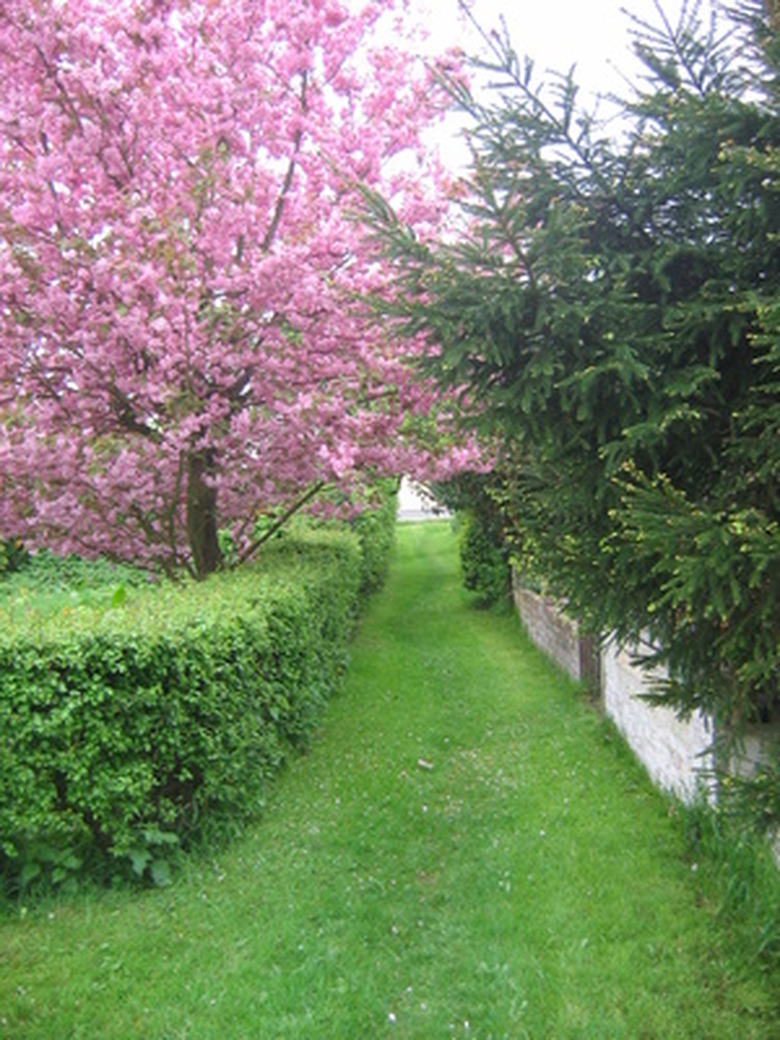Hedges That Grow In The Shade
Whether planted to create privacy or as an ornamental touch to the garden, hedges add depth and beauty to the landscape. But if your yard has large areas of full or partial shade, it is critical to select hedging plants that are suitable for low-light conditions. Fortunately, there are a number of evergreen plants that make excellent hedges for locations that are in full or partial shade.
Common Yew
The English or common yew is widely used for formal hedges and thrives in light conditions ranging from full sun to full shade. Although slow growing, Taxus baccata can be trained for hedges up to 25 feet high. The fine leaves form a dense, uniform foliage that is easily pruned into well defined shapes and requires little maintenance once established. The common yew is suitable for USDA plant hardiness zones 5 through 7.
- Whether planted to create privacy or as an ornamental touch to the garden, hedges add depth and beauty to the landscape.
- Although slow growing, Taxus baccata can be trained for hedges up to 25 feet high.
Japanese Laurel
Japanese laurel (Aucuba japonica) is an attractive evergreen shrub that makes a colorful hedge. The Gold Dust variety sports yellow fringed and spotted leaves that will brighten dark areas beneath tree cover or on the north side of a building. Growing in USDA hardiness zones 6 to 10, Japanese laurel typically grows to 10 feet in height if left unpruned. Female plants display bright red berries in the fall, which further adds to the colorful nature of this plant.
Common Boxwood
Known botanically as Buxus sempervirens, common boxwood is widely planted for ornamental hedges and topiary. Boxwood has a much narrower aspect than many hedges, usually growing no more that 18 to 24 inches wide. As such it is well suited for small yards and gardens where space is limited. Grown in USDA hardiness zones 5 through 8, this plant does well in both sun and shade. Boxwood grows only a few inches per year, on average, which keeps pruning to a minimum.
- Japanese laurel (Aucuba japonica) is an attractive evergreen shrub that makes a colorful hedge.
- Growing in USDA hardiness zones 6 to 10, Japanese laurel typically grows to 10 feet in height if left unpruned.
Red Twigged Dogwood
The red twigged dogwood (Cornus sericea) is a bushy shrub that can be trained into a hedge for shady areas. These plants need plenty of water and are a great choice for boggy areas that are too wet for most other species. The bark turns a distinctive burgundy color in winter, which adds some variation to the landscape. Known by many other common names including American dogwood and Western dogwood, this shrub will reach 10 feet in height without pruning.
English Laurel
English laurel (Prunus laurocerasus) grows vigorously in a wide range of soil and light conditions and can quickly provide both privacy and color to the garden. This evergreen is tolerant of poorly developed soil and wet ground, often thriving in locations that are impossible for other hedging plants. It can grow to 25 feet in height and be equally as wide, so regular pruning is essential to keep it trained to the desired size.
- The red twigged dogwood (Cornus sericea) is a bushy shrub that can be trained into a hedge for shady areas.
- This evergreen is tolerant of poorly developed soil and wet ground, often thriving in locations that are impossible for other hedging plants.
